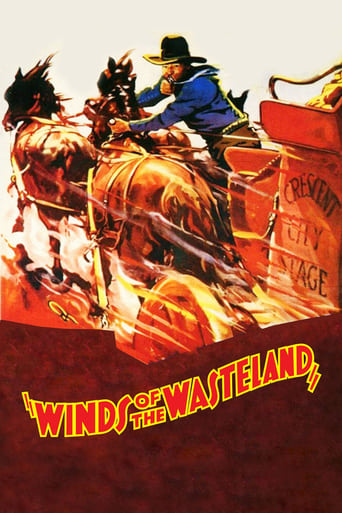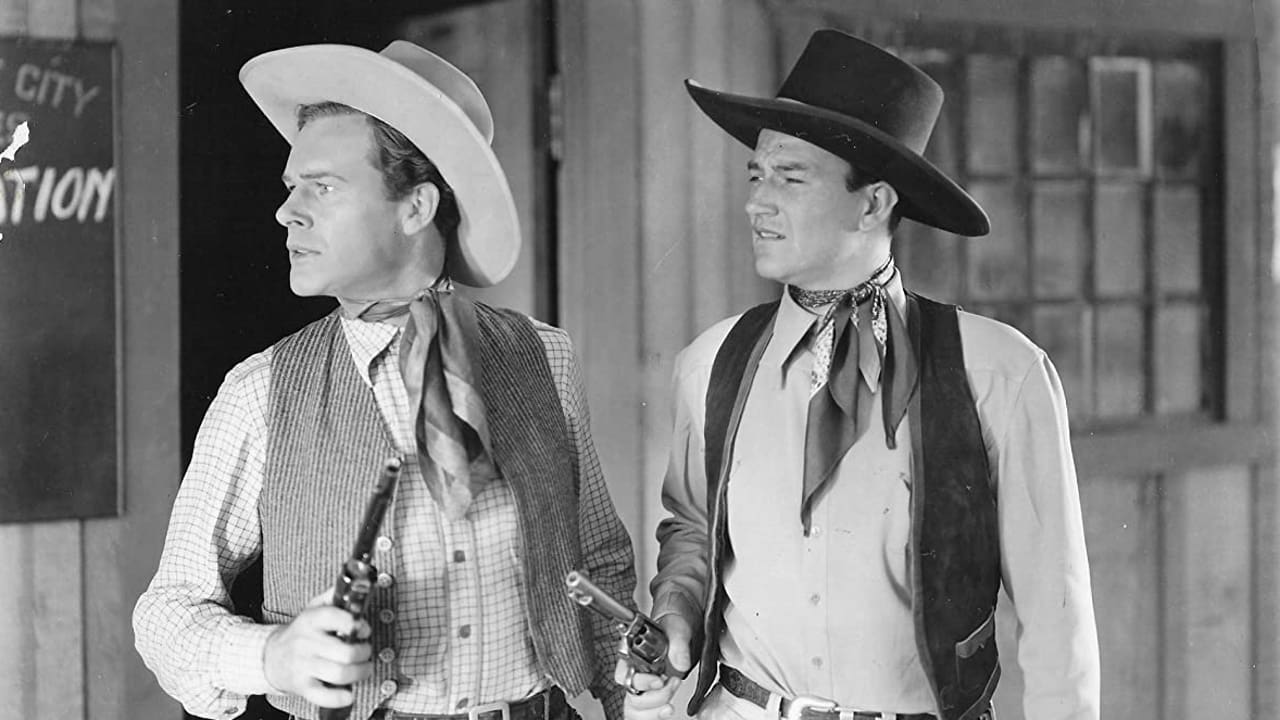JohnHowardReid
John Wayne (John Blair), Lane Chandler (Larry Adams), Phyllis Fraser (Barbara Forsythe), Douglas Cosgrove (Cal Drake), Sam Flint (Dr Forsythe), Lew Kelly (Rocky), Bob Kortman (Cherokee Joe), Jon Hall (Jim, a Pony Express rider), Yakima Canutt (Smokey), W. Merrill McCormick (Pete), Ed Cassidy (Dodge, the Pony Express manager), Chris Franke (Grahame, boss of the telegraph crew), Bud McClure, Jack Ingram (guards), Joe Yrigoyen (Pike), Jack Rockwell (marshal), Arthur Millett (postmaster), Tracy Layne (Reed), Art Mix (Ed, a Pony Express rider), Horace B. Carpenter (man with sick child), Herman Hack, Henry Hall, Murdock MacQuarrie, Clyde McClary, George Morrell, Francis Walker (townsmen), Bud Pope (henchman), Lloyd Ingraham (helpful old man), Cliff Lyons (Pony Express rider).Director: MACK V. WRIGHT. Original story and screenplay: Joseph Poland. Film editor: Robert Jahns. Supervising film editor: Murray Seldeen. Photography: William Nobles. Music supervisor: Harry Grey. Title music composed by Louis De Francesco. Stock background music by Heinz Roemheld, Arthur Kay, Paul Van Loan. Production supervisor: Paul Malvern. Sound recording: Terry Kellum. RCA Sound System. Producer: Nat Levine.Copyright 6 July 1936 by Republic Pictures Corporation. U.S. release: 15 June 1936. No recorded New York opening. U.K. release: June 1937. 6 reels. 58 minutes. COMMENT: One of the best of Wayne's pre-Stagecoach westerns, thanks to a superior screenplay by Joseph Poland, stylish direction by Mack V. Wright, an able group of support players, deft camera-work — and plenty of action. Wayne plays with a casually charming ease and is smoothly partnered by Lane Chandler, while Phyllis Fraser makes a convincing heroine and Lew Kelly a passable comedian. The villains are headed by a nicely confident Douglas Cosgrove, with Bob Kortman trailing along as a splendidly sneering henchman and Yakima Canutt in there pitching (and obviously doubling for Kortman in a lively punch-up with Wayne in which our hero does all his own fighting). The climactic stagecoach race is every bit as thrilling as the script promises with heaps of hard riding (excitingly filmed in running inserts), plus some really spectacular stunt-work.
John W Chance
For those who have watched John Wayne's 16 'Lone Star' westerns (1933-1935) (so cheaply available everywhere on DVD), this film is a major change in many ways. First, 'Lone Star' (Paul Malvern) has now become a part of the new Republic Pictures. Second, we now have a full length music sound track mostly timed to the on screen activity. Third, we get rear projection, so we don't always see John Wayne and the other players actually on the stagecoaches they are supposed to be handling. Fourth, we get an improved budget and new script writers, with the plot encompassing a far greater scope than any of the previous 'Lone Star' films. As the opening titles declare, this is a historical western with its theme the development of the West. It's an early Republic "American Spirit" film. Fifth, by this point in time the technology of film making, including sound reproduction, had significantly improved. The only thing that remains the same is the disconnect between the title of the film and what it is actually about.In this case, John Wayne (John Blair) and his Pony Express buddy Lane Chandler (Larry Adams) get tricked into buying a ghost town, Crescent City, which they magically transform into a thriving one in only a few days! Apparently, the same day Blair gets workers to go to Crescent City to help build the telegraph, it also suddenly becomes a rebuilt town complete with restored store fronts, new homes, and a Chinese laundry (with racist stereotypes and music).Forget the shootouts, chases, fights and the spectacular stunts of the Mighty Yak (Yakima Canutt) that were the core of so many of the 'Lone Star' films. This one is now like a real motion picture complete with characters and a bigger theme. Unfortunately, despite the other comments posted, this one is too pedestrian. There's not enough interplay between Blair and 'the girl' (here played by Ginger Roger's look alike cousin, Phyllis Cerf -- Bennett Cerf's wife). See, by contrast, 'Texas Terror' (1935) with its love triangle, or 'The Desert Trail' (1935) with a horny John Wayne, or even 'The Dawn Rider' (1935). Frankly, the stagecoach race isn't all that edge of your seat. Most of it is cutting between shots of single coaches not next to each other. You can find a more exciting chase sequence in 'Blue Steel' (1934). The comic old timer / low comic sidekick part (later played in other westerns by Al. St John, Fuzzy Knight, Max Terhune among countless others)adds idiotic contrast to the main action, and in fact, as another indication of what is to come in junk westerns, ends the film. (Let's not put Gabby Hayes, Andy Clyde, Smiley Burnett, Andy Devine and Leo Carillo in the former group, since they were more highly skilled performers and were the top sidekicks.)Some character building interplay is off stage. Lane Chandler's getting shot, being attended to and his surviving successful life saving surgery are played entirely off stage, and thus too quickly and glibly treated to be believable. A longer film would have really developed John Wayne's relationship with him (i.e., actually showing these scenes), as in their equal screen time pairing in the best 'Lone Star' western 'Sagebrush Trail' (1933). Poor Lane Chandler and his sky rocketing decline from silent movie hero to sidekick to bit player to uncredited. He was in over 400 TV shows, movies and serials (including appearances in all three 'Flash Gordon' serials)! Apparently, he was laughing all the way to the bank, as he became rich.The best part is John Wayne himself. Huskier, older, and even more charming than in his earlier films. What a fast draw on the villain!But finally we have to say that even though movies have transitioned from the pre-code any thing goes early thirties to more sophisticated techniques and technology in film making, this one disappoints. It doesn't stand out. It's in the category of post-1934 'streamlining' of the western. I'd give it a 4 and a half. If you want a real movie, watch 'Stagecoach' (1939) to see John Wayne in a full blown Movie Type Movie.
classicsoncall
John Wayne appeared in sixteen Westerns for Paul Malvern's Lone Star/Monogram Pictures, and stayed on for eight more films when the group merged with Republic in 1935. "Winds of the Wasteland" was the last one of these, and would be Wayne's final Western for a couple of years while working on six pictures for Universal in 1936/37. It's a lively story that teams The Duke up with Lane Chandler; they only appeared together once before in Lone Star's "Sagebrush Trail". With the dissolution of the Pony Express, the boys decide to form a stage line with the horses they receive in gratitude for their service.Wayne's character is John Blair, and along with Larry Adams (Chandler), the boys are quickly hoodwinked into buying a stagecoach route from Buchanan to Crescent City. The first sign of trouble comes when the signboard for Crescent City's population reads '2', ever since villain Cal Drake (Douglas Cosgrove) had a falling out with Doc Forsythe (Sam Flint), with the population of the town following him to Buchanan. It's a set up that doesn't make too much sense, but if you stay with it, you'll see that Blair stays one step ahead of Drake at every turn to revitalize Crescent City and win a government subsidy of twenty five thousand dollars.For those familiar with the work of stuntman extraordinaire Yakima Canutt, you'll recognize what might be considered a very early tryout for the chariot race in "Ben-Hur" some two decades later. The seeds of that epic movie scene might have been planted here with the thrilling stagecoach race to Sacramento between Blair and Drake. Blair outwits the villain's chicanery to win by a little more than a nose, thereby winning the government grant, along with Doc Forsythe's pretty daughter Barbara (Phyllis Fraser). In that respect, Wayne's character kept the streak intact of winning the lady's hand at the end of each of his early Westerns.Another reviewer for this film commented on Phyllis Fraser's resemblance to Ginger Rogers. Researching her background reveals that in fact, Fraser was a cousin of Rogers. Even more interesting, she was married to publisher Bennett Cerf for nearly thirty one years until his death in 1971, and then to former New York City mayor Robert Wagner until his death in 1991. Born Helen Nichols Brown, she used the name Phyllis Fraser for her entire film career. I'd be curious to know if the name derived from 'B' Western film director Harry Fraser, who did a couple of Wayne's Lone Star yarns.Anyway, getting back to the film, you should have some fun with this one, as Wayne keeps things upbeat even when he's being railroaded by baddie Drake throughout the story. Lew Kelly adds some comic relief as the mayor/postmaster/treasurer of Crescent City, who maintains a running gag with a skunk (the animal kind, not the human kind). It all comes in at a quick fifty four minute pace, quick enough to grow the population of Crescent from two to over four hundred in a blink. The only thing is, how did they ever come up with that title?
zetes
Not bad, just incredibly dull. Wayne and partner Lane Chandler try to start a stagecoach route through a ghost town. A rival stagecoach company tries to stop them. Some of the stuff near the beginning of the film is okay, and the lead actress is cute and looks a bit like Ginger Rogers. The final action sequence put me to sleep. 5/10.


 AD
AD




